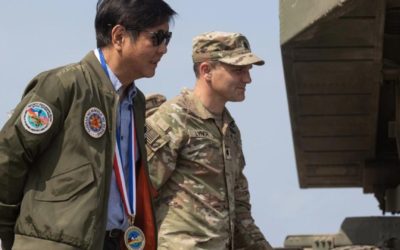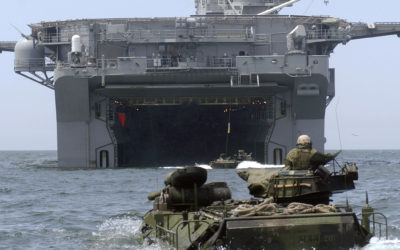On April 26, U.S. President Joe Biden welcomed South Korean President Yoon Suk-yeol to the White House for a summit meeting to celebrate the seventieth anniversary of the U.S.-South Korea alliance and open a new chapter for the next seventy years of expanded cooperation. Amid a substantial list of topics discussed by the two leaders, extended deterrence emerged as the top deliverable.
The Nexus Between Security Sector Governance/Reform and Sustainable Development Goal-16: An Examination of Conceptual Linkages and Policy Recommendations
The Nexus Between Security Sector Governance/Reform and Sustainable Development Goal-16: An Examination of Conceptual Linkages and Policy Recommendations
The Nexus Between Security Sector Governance/Reform and Sustainable Development Goal-16: An Examination of Conceptual Linkages and Policy Recommendations
The security-development nexus is not necessarily something new. The founders of the Bretton Woods system recognized it back in the 1940s (Zoellick 2008). In fact, in founding the International Bank for Reconstruction and Development (IBRD), which later has become the World Bank (WB) Group, they noted, ‘Programs of reconstruction and development will speed economic progress everywhere, will aid political stability and foster peace’ (The US Department of State Bulletin 1944: 114). Drawing on the same recognition, Rostow (1971) proposed a universalist model that perceives all nations rationally pursuing the goals of industrialization and material security, thereby lessening the causes of social conflict and promoting political stability. Rostow’s ‘optimistic philosophy is captured in US President John F. Kennedy’s motto “a rising tide lifts all boats,” which saw economic strategies overcoming racial and social inequalities domestically and development inequalities internationally’ (Pupavac 2010: 696). Nevertheless, it is important to note that Rostow’s theory has been criticized for its Westernized and neo-colonialist features (Jacobs 2015).
Development and security are essential for economic, social, and political stability. There is an important relationship between poverty, corruption, mismanagement of resources, and justice (UK Department for International Development [UK DFID] 2009). Having a well-functioning rule of law is necessary for sustaining peace and security. There are ‘negative consequences of insecurity on poverty reduction efforts’ (Bergenas & Mahoney 2016). Therefore, solely devoting attention to national economic development without security concerns might exacerbate insecurities that are already existent (Boyce 2002; Maresko 2004; Uvin 1998). While insecurity destroys the economic and political structure of a country, it also damages the access to justice.
The difference between negative and positive peace emerges as important to address at this conjuncture. In one of the earliest studies on the security-development nexus, Galtung (1964) defines negative peace as ‘the absence of violence, absence of war,’ and positive peace as ‘the integration of human society.’ The latter proves to serve as an important connection between the development and security spheres, as it contains ‘the attitudes, institutions and structures that create and sustain peaceful societies’ (Institute for Economics & Peace [IEP] 2020: 54). There are eight pillars of positive peace: ‘well-functioning government, sound business environment, accepting the rights of others, good relations with neighbors, free flow of information, high levels of human capital, low levels of corruption, and equitable distribution of resources,’ which make the connection between development and security clear (IEP 2020: 55).
Since the 1990s, there has been an increasing number of scholars and international organizations that recognize the interconnectedness among development and peace and security. Many scholars argued that the provision of security is a precondition for development and well-being (Krause & Jütersonke 2005; Schwarz 2005). Nevertheless, in the last decade or so, the international community has gradually started to view security and development as mutually reinforcing areas and acknowledged the need to achieve development and security concurrently, rather than addressing one as a precondition for addressing the other.
A quick overview of the major policy papers and reports adopted by the leading international organizations over time effectively illustrates this observation. International organizations, such as the United Nations (UN), the WB, the Organisation for Economic Co-operation and Development (OECD), and the European Union (EU), all published key documents that led the way for the international community to acknowledge the interconnected nature of security/peace and development.
This excerpt was republished under a Creative Commons license to point warfighters and national security professionals to reputable and relevant war studies literature. Read the original article here.

Dr. Oya Dursun-Özkanca (University of Texas at Austin, Ph.D.) is Endowed Chair of International Studies and Professor of Political Science at Elizabethtown College. Her research interests include transatlantic security, European Union, South East Europe, Eastern Mediterranean, and peace operations. She is the author of Turkey–West Relations: The Politics of Intra-alliance Opposition (Cambridge University Press, 2019). She is also the editor of The European Union as an Actor in Security Sector Reform (Routledge, 2014) and External Interventions in Civil Wars (co-edited with Stefan Wolff, Routledge, 2014). Her articles appeared in Foreign Policy Analysis, Civil Wars, European Security, and Ethnopolitics, among others.
Related Articles
President Marcos Jr. Meets With President Biden—But the U.S. Position in Southeast Asia is Increasingly Shaky
Over a four-day visit to Washington, Philippine President Ferdinand Marcos Jr. has been welcomed to the White House and generally feted across Washington. With President Biden, Marcos Jr. (whose father was forced out of office in part through U.S. pressure, and whose family has little love for the United States) affirmed that the two countries are facing new challenges, and Biden said that “I couldn’t think of a better partner to have than [Marcos Jr.].”
The U.S. is about to blow up a fake warship in the South China Sea—but naval rivalry with Beijing is very real and growing
As part of a joint military exercise with the Philippines, the U.S. Navy is slated to sink a mock warship on April 26, 2023, in the South China Sea.
The live-fire drill is not a response to increased tensions with China over Taiwan, both the U.S. and the Philippines have stressed. But, either way, Beijing isn’t happy – responding by holding its own staged military event involving actual warships and fighter jets deployed around Taiwan, a self-governed island that Beijing claims as its own.



